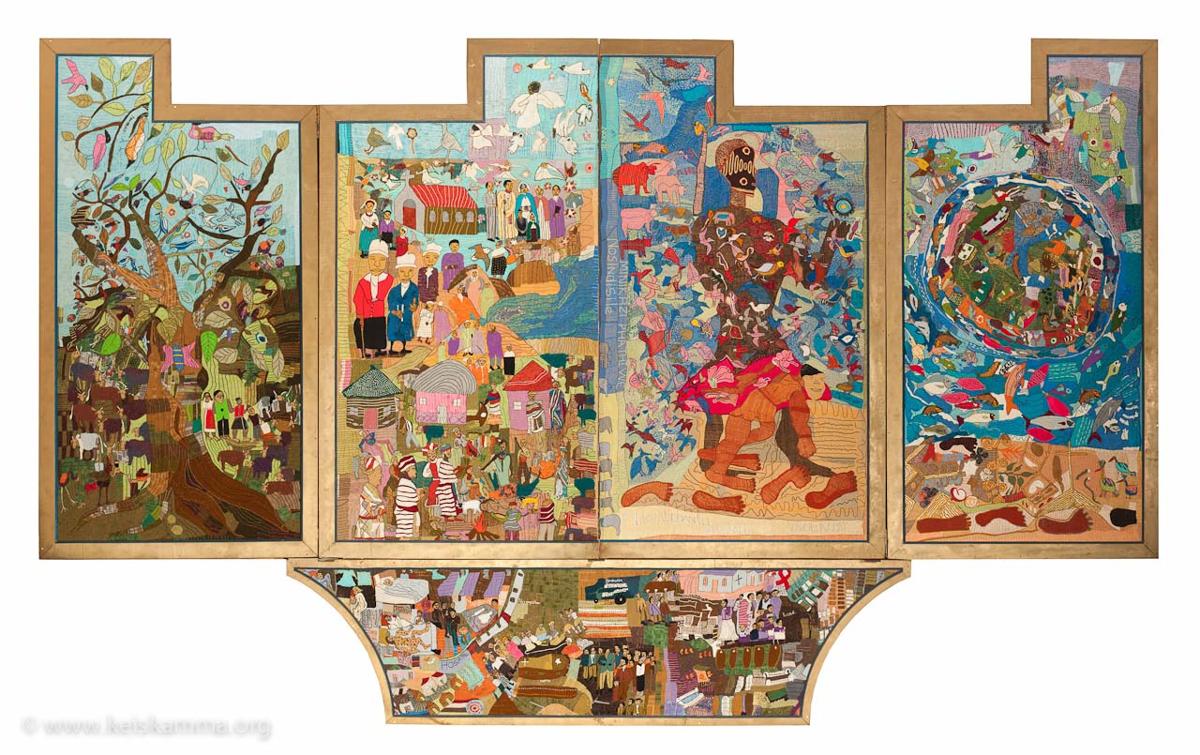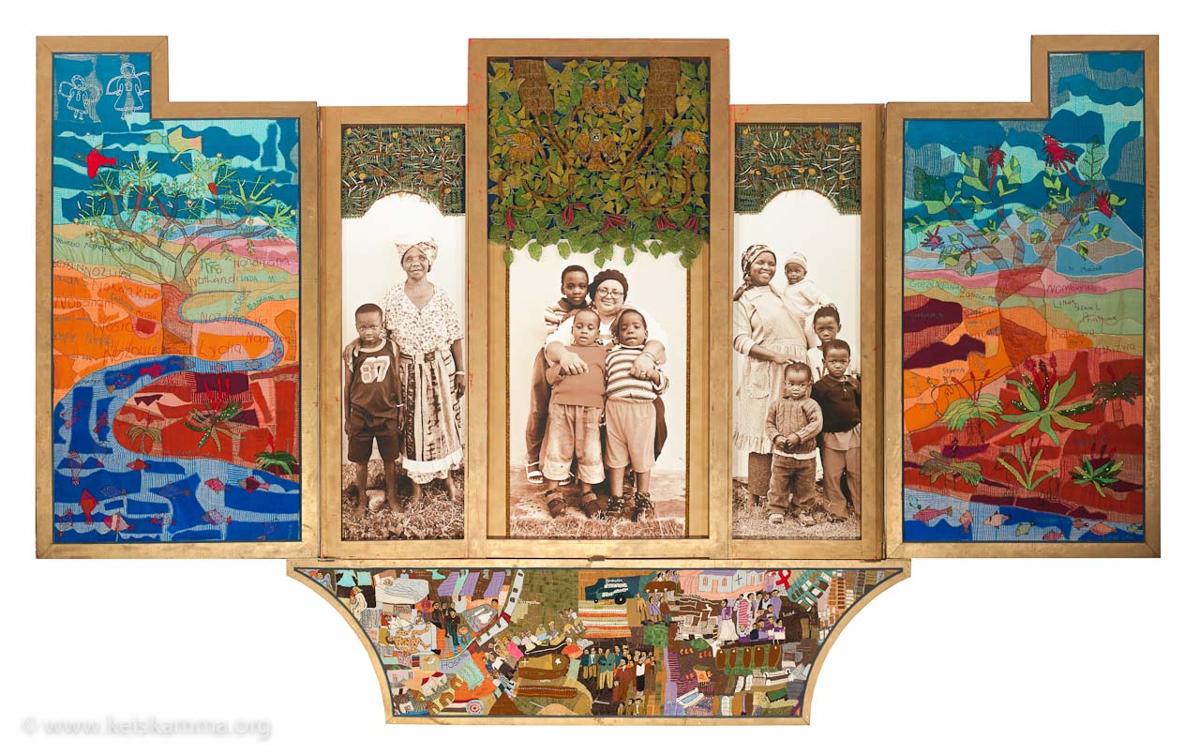December 21: Christ’s Expanded Definition of Family
♫ Music:
Day 20 - Friday, December 21
Christ’s Expanded Definition of Family
Scripture: Matthew 12:48-50
He replied to him, “Who is my mother, and who are my brothers?” Pointing to his disciples, he said, “Here are my mother and my brothers. For whoever does the will of my Father in heaven is my brother and sister and mother.”
Poetry:
American Mother
by Jae Newman
Ash watercolors wash through me
Like a beach forsaken by its border.
I know that beetles have crawled
Through the sound of television,
Stitched tiny sutures along my eyes.
The microwave hums its holy hymn
In praise of canned food--its heat
Is in my mouth. Quiet sufferer, why
Won’t you touch my hair anymore?
Standing by the window, I rinse
Aluminum lids free of tomato sauce,
Then force your hand into black sound.
Your arms are a sign language, jagged beams
Of shapeless color putting me to bed:
Kiss, a kiss! The outline of mother pixels
Against snowflake wallpaper is how
I know you best. Lights out, my slow-motion mother,
Missing my cheek in the dark.
“HE’S YOUR FAVORITE!”
If you are a parent of more than one child you’ve no doubt heard some version of this claim: some in our family get preferential treatment. Most likely, it comes from a child who feels left out. I remember one morning walking into one of my boy’s room to find him crying face down in a pillow. “What’s wrong?” I asked. Through sobs I heard him mutter, “You love the other two more than me!” The rest of the conversation was spent trying to tenderly convince him otherwise.
During his earthly ministry, Jesus faced the same charge that he was playing favorites. Specifically, some claimed that Jesus—and by implication God—favored those who fit into a certain ethnic heritage (Jews over Gentiles). Jesus refutes that charge by referencing the Ninevites and the Queen of Sheba as those who found God’s favor via repentance or seeking after divine wisdom (Mt. 12:38-42). His point was striking: faith trumps ethnic heritage. In today’s passage, Jesus is again confronted with an obvious case of favoritism. While he is teaching it is announced, “Look, your mother and your brothers are standing outside, seeking to speak with you” (vs. 47). With such a strong pronouncement—“Look, your mother and brothers are standing outside.”—the expectation is that Jesus will stop addressing the ordinary crowd and immediately attend to his own flesh and blood. Jesus’ answer is shocking and instructive. He responds: “Who is my mother and who are my brothers?” In one way the answer is obvious since we all only have one mother, or physical siblings. Rightfully, they should have priority. No so with Jesus. He proclaims that anyone who “does the will of my Father in heaven is my brother and sister and mother” (vs. 50).
In his landmark book, The Rise of Christianity, sociologist Rodney Stark sought to answer the puzzling question of how Christianity grew at such an unprecedented rate? In a cultural milieu strictly ordered by status where the educated, wealthy, land owners, and masters, towered over the uneducated, poor, slaves, and women, the early church offered an alternative. Regardless of social status, ethnicity, or gender, all who sought God equally entered into the Christian community. Thus, James unequivocally states that in this radical new community the wealthy and the poor are to be treated equally (2:3). Paul concurs and beautifully states that at the foot of the cross, “There is neither Jew nor Gentile, neither slave nor free, nor is there male and female, for you are all one in Christ Jesus” (Gal. 3:28).
The sad reality is that some parents, professors, pastors, and leaders do play favorites. Not so with Jesus and the early church. The radical message that guided this upstart movement was simple: the family of faith transcends ethnicity, social status, and most surprisingly, familial relationships. No exceptions. No favorites.
Prayer:
Father, as we understandably focus on the needs of our family during this Advent season, let us also be attentive to the needs of those who comprise our family of faith.
Amen.
Tim Muehlhoff
Professor of Communication
Biola University
About the Artwork:
Keiskamma Altarpiece, 2005 (3 views)
Keiskamma Art Project
Embroidery and wired beadwork on hinged wood panels
13.6 ft x 22.3 ft
This altarpiece tells the story of a Khosa community in the impoverished rural Eastern Cape Province of South Africa devastated by the HIV/AIDS epidemic and their journey to hope in the midst of great suffering and loss. It was inspired by Matthias Grünewald's Isenheim Altarpiece, painted in the 16th century for a monastery in Colmar, Alsace, to provide comfort and hope to people suffering from an incurable disease also of epidemic proportions. The Keiskamma Altarpiece celebrates the strength of grandmothers who willingly take up the responsibility of raising the children orphaned in such times. The closed altarpiece pictures a widow and her orphaned children mourning the loss of her husband who has succumbed to AIDS flanked by two matron “saints” of the community in the side panels. The center panels open to a vision of hope and renewal with scenes of abundant life, worship, harmonious village life, and a Khosa prophet running prayers in the sand. The final set of panels open to reveal life-size black and white photographs of grandmothers in the community with the children they were left to raise, sheltered under a glorious verdant canopy of coral and acacia trees with birds lighting on the branches made of three-dimensional wire beadwork. The predella below presents the funeral of one of the sons who has died from AIDS.
About the Artists:
The Keiskamma Art Project is one aspect of a much larger initiative based in the South African village of Hamburg to rejuvenate a people and place “fractured by generations of conflict and suppression.” It takes its name from the Keiskamma River that weaves its way through the harsh scrubland of South Africa’s Eastern Cape Province. It was initiated by Dr. Carol Hofmeyr, a medical doctor serving this community ravaged by the HIV/AIDS epidemic, when she realized that the community needed more than the medical care she could provide; it needed hope and a means to tell its story in order to heal and look to the future. The Keiskamma Art Project brings together well over 100 women and some men from Hamburg and neighboring villages to design and create collaborative artworks that tell their stories often inspired by large-scale historic masterpieces like the Ghent Altarpiece and Bayeux Tapestry, translating western media and forms into their own style and African traditions. Their works are a source of hope and inspiration all over the world.
About the Music:
“Bayalibuza” from the album Afrika Mamas
Lyrics
Bayalibuza!
Iyo! Bayalibuza we bakwethu
Wo, bathi lelivangeli
Liyintoni na? - “Sing”
Asilazi, - nithini?
Asilazi, - kodwa
Solibona ngemsebenzi yalo
Wo, nampa belibuza
Wo, sebeyalibuza, ngapha nangapha
Wo, bathi lelivangeli
Liyintoni na - “Sing”
Inkunzi enjani le
Emnyama endlela
Siqhamka lemazweni
Sithethelelw’ izono
uJesu namhlanje
Sathan’ uzoyidel’ inkani
Ngiyamthand’ owangifela
uJesu lo
Hayayaya, owangifela
Qha, mina angigedwa
Owangifela ngiyamthanda
Qha, angingedwa, uyangithanda
[Translation]:
You, there in the darkness
You, there in the night
You who look to heaven
And wait for a miracle
You here in the labyrinth
And you are forgotten
You who seek the light
And who wants to break the chains
You do not think alone
You do not dream alone
You do not stand alone
Because we are at your side
About the Composers, Lyricists, and Performers:
Afrika Mamas and Stef Bos
Formed in 1996, the Afrika Mamas (initially named Women Of Afrika) consists of singers who had previously worked as backing singers for a range of established South African and Afrikaans artists. Afrika Mamas sing in an a cappella or Mbube style, featuring rich textures, thick harmonies, reminiscent of Ladysmith Black Mambazo. The Afrika Mamas now consist of six singers who take on a range of vocal duties from bass right up to soprano. Significantly, each Mama is a single mother and their life experiences are reflected in the subject matter of their songs with the latest album in particular highlighting the plight and challenges of women in today's South Africa with a defiance and determination to change things for the better. Beyond their home continent, the Mamas have toured extensively with visits to countries as far afield as China, Belgium, Holland, Sweden, Spain, and Great Britain.
Steven "Stef" Bos (b. 1961) is a Dutch singer who has been living in Cape Town, South Africa. He sings in Dutch (and occasionally in Afrikaans), and has been successful in Belgium, the Netherlands, and South Africa ever since his breakthrough single "Papa" (Daddy) came out in 1990. He wrote Belgium's entry into the 1989 Eurovision Song Contest, "Door De Wind.” Stef recorded an album (Together as One) in 1993 on which he worked together with Johannes Kerkorrel and Tandie Klaasen, two famous South African singers. From that moment on he fell in love with South Africa, the language Afrikaans and its music.
About the Poet:
Jae Newman, born in South Korea, is a poet, author, and teacher who lives in Rochester, NY, with his wife and three children. He teaches writing courses at Roberts Wesleyan College and Monroe Community College. A graduate of the MFA in Writing Program at Spalding University, he holds an MFA in Writing from Spalding University (2006) and an MA in Theological Studies from Northeastern Seminary (2015). Newman's recent artistic engagement involves blending deep interests of poetry and theology while investigating the humanitarian crisis in North Korea. His first book of poetry, Collage of Seoul, is available through Cascade Books. His work has appeared in several journals including The Bellingham Review, The Louisville Review, and 5 AM. He received a nomination for a Pushcart Prize. Currently he is working toward a Master of Arts in Theological Studies at Northeastern Seminary.
About the Devotional Writer:
Tim Muehlhoff
Professor of Communication
Biola University
Tim Muehlhoff is a professor of communication at Biola University where he teaches classes on family communication, gender, persuasion, and apologetics. In addition to teaching, Tim is an author whose newest release is Defending Your Marriage: The Reality of Spiritual Battle (IVP). He currently serves as an author/speaker with Biola’s Center for Marriage and Relationships.


